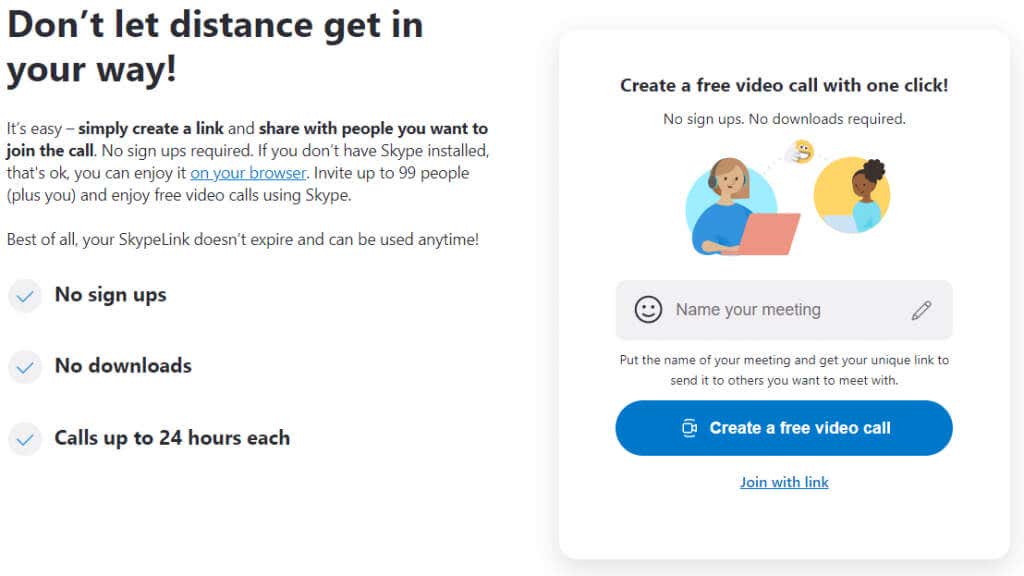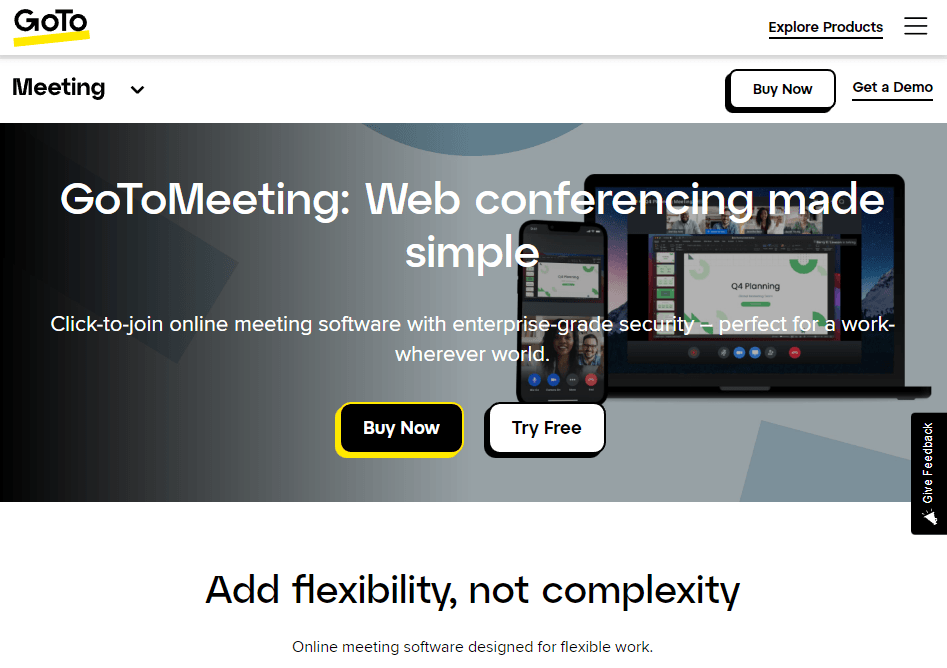For those that want to try something different
Zoom has become a staple for video conferencing ever since remote work became the new normal as a result of the coronavirus pandemic. It has a generous free version that allows screen sharing, up to 100 participants, unlimited meetings for up to 40 minutes, and other features including:
- Screen sharing
- Virtual background (you can also create custom Zoom backgrounds)
- Breakout rooms
- 3 whiteboards
- Apps for smartphones and desktop
However, some people don’t like Zoom’s interface. Others want more features that Zoom doesn’t offer on its free plan or only offers on its top-tier plan. For instance, say you need to host meetings longer than 40 minutes. Zoom might not be the best option unless you switch to one of the paid plans.
If you’re a small business or an enterprise looking for a messaging and video meetings app that can work as a substitute for Zoom, we’ve got 8 of them for you. In this guide, we explain there 8 other services that are worthy Zoom alternatives.
8 Best Zoom Alternatives in 2022
Following are the best Zoom alternatives for paid and free video calls. Some of them offer a better free plan, while others offer better functionality.
1. Google Meet
Google Meet is a go-to Zoom alternative because most companies already use other G Suite tools in some capacity. Google Meet offers slightly longer meeting durations of 60 minutes on its free plan (20 minutes longer than Zoom), though it offers the same number of maximum participants (100) per meeting.
Here are other features you get with Google Meet’s free plan:
- Unlimited meetings
- Live captions powered by Google’s speech recognition (English only)
- Compatibility with all popular devices: Desktop, laptop, Android, and iOS
- Adjustable layouts
- Controls for hosts (including muting, removing, and pinning participants)
- Screen sharing
- Integration with Gmail, Google Calendar, Office 365, and Outlook Calendar
If you’re an enterprise user with a large team, you can upgrade to the Enterprise plans for hosting online meetings with up to 250 participants. You can also live-stream meetings (or host a webinar) to up to 100,000 attendees and record Google Meet meetings with the Enterprise plan.
You don’t get a lot of advanced features on Google Meet, but it offers everything you need to host high-quality and frictionless video conferences. When selecting between Google Meet vs. Zoom, it boils down to just using a tool that allows you the flexibility to host slightly longer meetings and integrates with tools you already use.
Google also has other video conferencing platforms for various purposes. For instance, you can use Google Hangouts for personal video calls or Google Voice if you need VoIP calling features.
2. Microsoft Teams
Microsoft Teams is a cloud-based video conferencing app from Microsoft and comes installed by default on the latest version of Windows, Windows 11. Most features on Microsoft Teams are more or less similar to Zoom and include:
- Unlimited group meetings for up to 60 minutes
- Up to 300 participants per meeting (a big plus when compared to 100 participants on Zoom)
- Unlimited chat with coworkers and customers
- File sharing
- Change the background (or upload your own)
- Live captions
- 5GB of cloud storage (compared to 25MB on Zoom)
So, is Microsoft Teams better than Zoom? Well, it depends on your exact needs. However, if you need more features, you can choose the Microsoft Teams Essentials ($4 per user per month), Microsoft 365 Business Basic ($6 per user per month), or Microsoft 365 Business Standard ($12.50 per user per month).
3. Skype
Skype has been around for a long time, but is Skype better than Zoom? It was initially a video chat app meant for personal use. Skype offers most features for free and continues to evolve as a video conferencing platform for individuals rather than businesses.
If you’re a solopreneur or a small team, you can use Skype Meet Now. The video conferencing software offers the following on its free plan:
- Up to 100 participants in a meeting room
- Call recording
- Change background
- End-to-end encryption
- Screen sharing
- File sharing (for files up to 300MB in size)
- Call forwarding
Almost all features are available on the free plan except calling mobile phones and landlines (which cost $2.99 per month for unlimited minutes). You can also get a Skype number from another country to make and receive calls and send and receive text messages like you would if you were in that country.
4. GoToMeeting
GoToMeeting allows up to 150 participants and up to 50 breakout rooms, even on the cheapest plan. You get unlimited cloud recording storage and transcriptions for those recordings (only available on the two higher-tier plans), so you can search through meeting conversations quickly.
The biggest downside to GoToMeeting is the lack of a free plan, but here are more features you get on GoToMeeting’s paid plans:
- Co-hosting functionality
- Screen sharing
- Interactive whiteboard
- Drawing tools
- Smart Assistant (Machine learning-powered detection system that detects action items and highlights in a meeting)
- In-meeting notes
- Slide to PDF (GoToMeeting captures presentation slides and creates chronologically-ordered and shareable PDF files)
- Plug-ins for Google Calendar and Microsoft Office 365
However, GoToMeeting lacks webinar functionality. To host a webinar, you’ll need to spend extra on GoToWebinar, GoTo’s webinar product.
5. RingCentral
RingCentral is geared towards enterprise users who need a video conferencing solution and other communication and team collaboration tools too. RingCentral’s video conferencing tool gives you a lot more capabilities than some free tools we have on the list.
For instance, RingCentral allows hosting video conference calls with up to 500 meeting participants, lets you switch between audio and video calls, and change the device you’re using for the meeting without dropping out of the call.
RingCentral doesn’t offer a free plan, but here’s a list of features you get on its paid plans:
- Meeting recording
- Whiteboard and annotations for easier collaboration
- Screen sharing
- Real-time file editing
- Up to 50 breakout rooms
- Integrations for popular CRMs, Zapier, Microsoft Outlook, Google Workspace (Google Calendar, Gmail, etc.), and more
- Real-time analytics
- Webinar feature allowing up to 10,000 attendees
The only downside to RingCentral is that it’s expensive. The pricing is also a little complex, with the tier-wise rates changing as your team grows larger.
6. BlueJeans
BlueJeans is a cloud-based video conferencing service best suited for small teams rather than individuals or enterprise users.
The platform does offer a few enterprise-focused capabilities, though. For instance, you can host up to 50,000 view-only members. There’s no free plan, but you can try BlueJeans with all features using the 7-day free trial.
The paid plans (Standard, Pro, and Enterprise) on BlueJeans offer the following features:
- Up to 50, 75, and 100 participants on the lowest, medium, and highest-tier plans, respectively
- Available on Windows (not with touchscreen Windows devices, though), Apple devices (Mac, iPhone, and iPad), and Linux
- Smart Meetings (helps pin important moments in the meeting and assign action items to participants)
- Whiteboard and annotations
- File sharing
- Private and group chats
- Polling, Q&A, raising hands, and other interactive features
- Live-stream events on Facebook
- Integrations for Slack, Microsoft Office 365, Gong, and more
Overall, BlueJeans is great for small teams that only need video conferencing features and not many other communication features.
7. Cisco Webex
Cisco is a video conferencing tool that allows hosting HD video calls and offers a range of collaboration features, including file sharing and call recording.
The best part? Webex has a generous free plan that allows hosting up to 100 team members for 50-minute meetings. You can always increase the meeting duration to 24 hours by upgrading to a paid plan. However, if you want to host more participants, you’ll need to upgrade to one of the higher-tier plans.
Upgrading to the Premium plan allows unlimited hosts to host up to 100,000 participants. Here are other features you get on Webex’s paid plans:
- Interactive whiteboard
- Screen sharing
- Dial-in access
- Call recording
- File transfer
- Transcriptions
- Polling
- Top-notch security features like firewall, SSO, and secure scheduling
- Integrations for Office 365, Google Drive, and Salesforce
- Live customer support
Cisco Webex is also loaded with AI features like gesture-based meeting reactions. Webex’s AI also finds the meeting’s most important points, puts them at the top, and saves relevant shared files with those points.
8. Jitsi Meet
Jitsi Meet is a free, open-source video conferencing solution. If you’re a startup or small business, Jitsi Meet is a great way to collaborate with your team on video. You can host up to 50 members in a meeting by inviting them with a meeting link or directly calling them.
Here are a few features you get on Jitsi Meet:
- Screen sharing
- Stream live meetings to YouTube
- Features like “pass presenter,” viewing scheduled meetings, and connecting to the calendar for scheduling future meetings
- Control every participant’s desktop remotely
- Integrations for Slack, Google, and Microsoft
- Available video quality resolutions: 1280×720 (HD), 640×360 (SD), and 360×180 (LD)
Since Jitsi Meet is an open-source platform, it’s highly customizable and allows you to add several advanced features. Of course, if you’re not a developer, you might just prefer paying for those features on a paid tool.
You can use Jitsi Meet via its web app, Android or iOS mobile app, or Chrome extension and integrate it with other business tools like Dropbox, Slack, Google Calendar, and Microsoft 365.
Zoom Alternatives Explained
Now that you know the Zoom alternatives available to you, you can go ahead and pick one that best fits your needs. However, if you don’t really need video chats, you can also just use one of the best free calling apps that offer unlimited calls and text messages.













